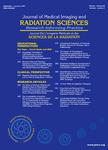版权所有:内蒙古大学图书馆 技术提供:维普资讯• 智图
内蒙古自治区呼和浩特市赛罕区大学西街235号 邮编: 010021

作者机构:Dartmouth Coll Thayer Sch Engn Hanover NH 03755 USA Dartmouth Hitchcock Med Ctr Norris Cotton Canc Ctr Dept Med Radiat Oncol Lebanon NH 03766 USA DoseOptics LLC Lebanon NH 03755 USA Univ Penn Perelman Sch Med Dept Radiat Oncol Philadelphia PA 19104 USA Univ Wisconsin Madison Dept Med Phys Wisconsin Rapids WI 53705 USA Yale Univ Positron Emiss Tomog PET Ctr New Haven CT 06520 USA
出 版 物:《JOURNAL OF MEDICAL IMAGING AND RADIATION SCIENCES》 (医学成像与放射科学杂志)
年 卷 期:2022年第53卷第4期
页 面:612-622页
学科分类:1002[医学-临床医学] 1009[医学-特种医学] 10[医学]
基 金:NIH [R01 EB023909, R21 CA239127] Dartmouth Cancer Center [P30 CA023108] National Cancer Institute [R21CA239127] Funding Source: NIH RePORTER
主 题:Electron therapy Monte Carlo Animation Visualization Computer graphics
摘 要:Introduction/Background: The goal of Total Skin Electron Therapy (TSET) is to achieve a uniform surface dose, although assessment of this is never really done and typically limited points are sampled. A computational treatment simulation approach was developed to estimate dose distributions over the body surface, to compare uniformity of (i) the 6 pose Stanford technique and (ii) the rotational technique. Methods: The relative angular dose distributions from electron beam irradiation was calculated by Monte Carlo simulation for cylinders with a range of diameters, approximating body part curvatures. These were used to project dose onto a 3D body model of the TSET patient s skin surfaces. Computer animation methods were used to accumulate the dose values, for display and analysis of the homogeneity of cover-age. Results: The rotational technique provided more uniform coverage than the Stanford technique. Anomalies of under dose were observed in lateral abdominal regions, above the shoulders and in the perineum. The Stanford technique had larger areas of low dose laterally. In the rotational technique, 90% of the patient s skin was within +/- 10% of the prescribed dose, while this percentage decreased to 60% or 85% for the Stanford technique, varying with patient body mass. Interestingly, the highest discrepancy was most apparent in high body mass patients, which can be attributed to the loss of tangent dose at low angles of curvature. Discussion/Conclusion: This simulation and visualization approach is a practical means to analyze TSET dose, requiring only optical sur-face body topography scans. Under-and over-exposed body regions can be found, and irradiation could be customized to each patient. Dose Area Histogram (DAH) distribution analysis showed the rota-tional technique to have better uniformity, with most areas within 10% of the umbilicus value. Future use of this approach to analyze dose coverage is possible as a routine planning tool.